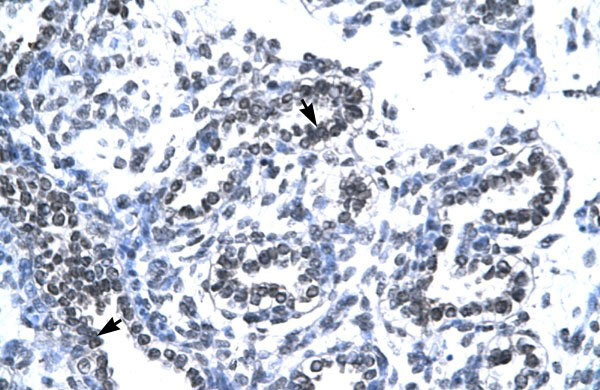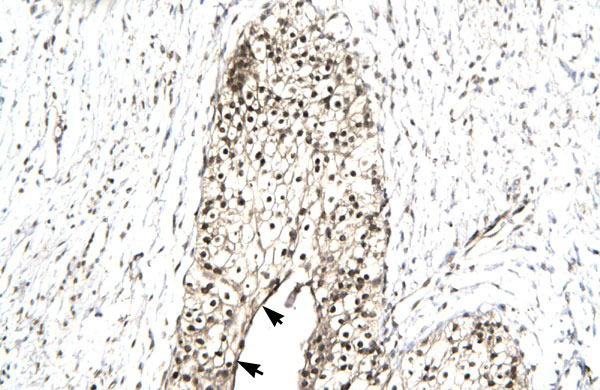RUVBL2 antibody - N-terminal region
Rabbit Polyclonal Antibody
- 产品详情
- 实验流程
- 背景知识
Application
| WB, IHC |
|---|---|
| Primary Accession | Q9Y230 |
| Other Accession | Q9Y230, NP_006657, NM_006666 |
| Reactivity | Human, Mouse, Rat, Rabbit, Zebrafish, Pig, Dog, Guinea Pig, Horse, Bovine, Yeast |
| Predicted | Mouse, Rat, Rabbit, Zebrafish, Pig, Dog, Guinea Pig, Horse |
| Host | Rabbit |
| Clonality | Polyclonal |
| Calculated MW | 51157 Da |
| Gene ID | 10856 |
|---|---|
| Alias Symbol | RVB2, TIH2, ECP51, TIP48, CGI-46, INO80J, REPTIN, TIP49B |
| Other Names | RuvB-like 2, 48 kDa TATA box-binding protein-interacting protein, 48 kDa TBP-interacting protein, 51 kDa erythrocyte cytosolic protein, ECP-51, INO80 complex subunit J, Repressing pontin 52, Reptin 52, TIP49b, TIP60-associated protein 54-beta, TAP54-beta, RUVBL2, INO80J, TIP48, TIP49B |
| Target/Specificity | RuvB-Like 2 (48-kDa TATA box-binding protein-interacting protein, Reptin 52, RUVBL2) is the second human homologue of the bacterial RuvB gene. Bacterial RuvB protein is a DNA helicase essential for homologous recombination and DNA double-strand break repair. Functional analysis showed that this protein has both ATPase and DNA helicase activities. This gene is physically linked to the CGB/LHB gene cluster on chromosome 19q13.3, and is very close (55 nt) to the LHB gene, in the opposite orientation. |
| Format | Liquid. Purified antibody supplied in 1x PBS buffer with 0.09% (w/v) sodium azide and 2% sucrose. |
| Reconstitution & Storage | Add 100 ul of distilled water. Final anti-RUVBL2 antibody concentration is 1 mg/ml in PBS buffer with 2% sucrose. For longer periods of storage, store at -20°C. Avoid repeat freeze-thaw cycles. |
| Precautions | RUVBL2 antibody - N-terminal region is for research use only and not for use in diagnostic or therapeutic procedures. |
| Name | RUVBL2 |
|---|---|
| Synonyms | INO80J, TIP48, TIP49B |
| Function | Possesses single-stranded DNA-stimulated ATPase and ATP- dependent DNA helicase (5' to 3') activity; hexamerization is thought to be critical for ATP hydrolysis and adjacent subunits in the ring- like structure contribute to the ATPase activity (PubMed:10428817, PubMed:17157868, PubMed:33205750). Component of the NuA4 histone acetyltransferase complex which is involved in transcriptional activation of select genes principally by acetylation of nucleosomal histones H4 and H2A (PubMed:14966270). This modification may both alter nucleosome -DNA interactions and promote interaction of the modified histones with other proteins which positively regulate transcription (PubMed:14966270). This complex may be required for the activation of transcriptional programs associated with oncogene and proto-oncogene mediated growth induction, tumor suppressor mediated growth arrest and replicative senescence, apoptosis, and DNA repair (PubMed:14966270). The NuA4 complex ATPase and helicase activities seem to be, at least in part, contributed by the association of RUVBL1 and RUVBL2 with EP400 (PubMed:14966270). NuA4 may also play a direct role in DNA repair when recruited to sites of DNA damage (PubMed:14966270). Component of a SWR1-like complex that specifically mediates the removal of histone H2A.Z/H2AZ1 from the nucleosome (PubMed:24463511). Proposed core component of the chromatin remodeling INO80 complex which exhibits DNA- and nucleosome-activated ATPase activity and catalyzes ATP- dependent nucleosome sliding (PubMed:16230350, PubMed:21303910). Plays an essential role in oncogenic transformation by MYC and also modulates transcriptional activation by the LEF1/TCF1-CTNNB1 complex (PubMed:10882073, PubMed:16014379). May also inhibit the transcriptional activity of ATF2 (PubMed:11713276). Involved in the endoplasmic reticulum (ER)-associated degradation (ERAD) pathway where it negatively regulates expression of ER stress response genes (PubMed:25652260). May play a role in regulating the composition of the U5 snRNP complex (PubMed:28561026). |
| Cellular Location | Nucleus matrix. Nucleus, nucleoplasm. Cytoplasm. Membrane. Dynein axonemal particle {ECO:0000250|UniProtKB:Q9DE27} Note=Mainly localized in the nucleus, associated with nuclear matrix or in the nuclear cytosol. Although it is also present in the cytoplasm and associated with the cell membranes |
| Tissue Location | Ubiquitously expressed. Highly expressed in testis and thymus. |
For Research Use Only. Not For Use In Diagnostic Procedures.
Provided below are standard protocols that you may find useful for product applications.
BACKGROUND
This is a rabbit polyclonal antibody against RUVBL2. It was validated on Western Blot and immunohistochemistry by Abgent. At Abgent we manufacture rabbit polyclonal antibodies on a large scale (200-1000 products/month) of high throughput manner. Our antibodies are peptide based and protein family oriented. We usually provide antibodies covering each member of a whole protein family of your interest. We also use our best efforts to provide you antibodies recognize various epitopes of a target protein. For availability of antibody needed for your experiment, please inquire (sales@abgent.com).
终于等到您。ABCEPTA(百远生物)抗体产品。
点击下方“我要评价 ”按钮提交您的反馈信息,您的反馈和评价是我们最宝贵的财富之一,
我们将在1-3个工作日内处理您的反馈信息。
如有疑问,联系:0512-88856768 tech-china@abcepta.com.























 癌症的基本特征包括细胞增殖、血管生成、迁移、凋亡逃避机制和细胞永生等。找到癌症发生过程中这些通路的关键标记物和对应的抗体用于检测至关重要。
癌症的基本特征包括细胞增殖、血管生成、迁移、凋亡逃避机制和细胞永生等。找到癌症发生过程中这些通路的关键标记物和对应的抗体用于检测至关重要。 为您推荐一个泛素化位点预测神器——泛素化分析工具,可以为您的蛋白的泛素化位点作出预测和评分。
为您推荐一个泛素化位点预测神器——泛素化分析工具,可以为您的蛋白的泛素化位点作出预测和评分。 细胞自噬受体图形绘图工具为你的蛋白的细胞受体结合位点作出预测和评分,识别结合到自噬通路中的蛋白是非常重要的,便于让我们理解自噬在正常生理、病理过程中的作用,如发育、细胞分化、神经退化性疾病、压力条件下、感染和癌症。
细胞自噬受体图形绘图工具为你的蛋白的细胞受体结合位点作出预测和评分,识别结合到自噬通路中的蛋白是非常重要的,便于让我们理解自噬在正常生理、病理过程中的作用,如发育、细胞分化、神经退化性疾病、压力条件下、感染和癌症。









